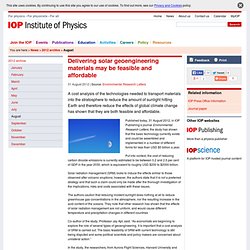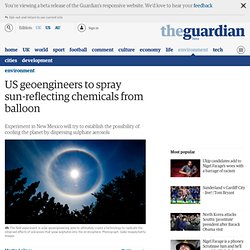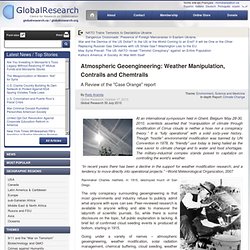

Geoengineering for global warming: Increasing aerosols in atmosphere would make sky whiter. One idea for fighting global warming is to increase the amount of aerosols in the atmosphere, scattering incoming solar energy away from Earth's surface.

Sun-Reflecting Projects Cheapest Way to Halt Global Warming? What would be the price tag for shielding the Earth from global warming using a chemical cloud?

It might be just $1 billion to $3 billion, making a sun-reflecting project much cheaper than combating climate change by reducing emissions and preserving forests to take up carbon dioxide, a new study has found. That doesn't mean the study's authors recommend sun-reflecting projects over other measures suggested to help prevent global warming and slow climate change, such as cutting back on electricity use, they say. "Such a claim could be sensibly made only after thorough investigation of the implications of risks and of the imperfect climate compensation offered by SRM [solar radiation management]," business and environment analysts from different U.S. institutions wrote in their paper, published yesterday (Aug. 30) in the journal Environmental Research Letters.
Their paper isn't intended to evaluate the effectiveness or risk of such measures, just cost, they said. Cost analysis of stratospheric albedo modification delivery systems. Delivering solar geoengineering materials may be feasible and affordable. 31 August 2012 | Source: Environmental Research Letters A cost analysis of the technologies needed to transport materials into the stratosphere to reduce the amount of sunlight hitting Earth and therefore reduce the effects of global climate change has shown that they are both feasible and affordable.

Published today, 31 August 2012, in IOP Publishing’s journal Environmental Research Letters, the study has shown that the basic technology currently exists and could be assembled and implemented in a number of different forms for less than USD $5 billion a year. Put into context, the cost of reducing carbon dioxide emissions is currently estimated to be between 0.2 and 2.5 per cent of GDP in the year 2030, which is equivalent to roughly USD $200 to $2000 billion. Geoengineering is 'comparatively inexpensive' US geoengineers to spray sun-reflecting chemicals from balloon. Two Harvard engineers are to spray sun-reflecting chemical particles into the atmosphere to artificially cool the planet, using a balloon flying 80,000 feet over Fort Sumner, New Mexico.

The field experiment in solar geoengineering aims to ultimately create a technology to replicate the observed effects of volcanoes that spew sulphates into the stratosphere, using sulphate aerosols to bounce sunlight back to space and decrease the temperature of the Earth. David Keith, one of the investigators, has argued that solar geoengineering could be an inexpensive method to slow down global warming, but other scientists warn that it could have unpredictable, disastrous consequences for the Earth's weather systems and food supplies.
Uld an artificial volcano cool the planet by dimming the sun? Dimming the sun by engineering the effects of an artificial volcano is a feasible and potentially cost-effective option to reduce temperatures on Earth, a report says.

Photograph: AP Dimming the sun by engineering the effects of an artificial volcano is a feasible and potentially cost-effective option to reduce temperatures on Earth, the first major study of the practicality of planetary-scale solar radiation management (SRM) concludes. The authors, US aerospace company Aurora Flight Sciences, consider the challenge of lifting and releasing 1-5m tonnes a year of sulphur dioxide to altitudes approaching 100,000ft. Atmospheric Geoengineering: Weather Manipulation, Contrails and Chemtrails. At an international symposium held in Ghent, Belgium May 28-30, 2010, scientists asserted that “manipulation of climate through modification of Cirrus clouds is neither a hoax nor a conspiracy theory.”

It is “fully operational” with a solid sixty-year history. Though “hostile” environmental modification was banned by UN Convention in 1978, its “friendly” use today is being hailed as the new savior to climate change and to water and food shortages. The military-industrial complex stands poised to capitalize on controlling the world’s weather. “In recent years there has been a decline in the support for weather modification research, and a tendency to move directly into operational projects.” ~World Meteorological Organization, 2007 Rainmaker Charles Hatfield, in 1915, destroyed much of San Diego. Ocean Acidity Rivals Climate Change As Environmental Threat. Solar radiation management. Removing trees from snowy landscapes can help reflect more sunlight into space[1] at latitudes that have meaningful incoming solar energy in the winter.
A study by Lenton and Vaughan suggest that marine cloud brightening and stratospheric sulfate aerosols are each capable of reversing the warming effect of a doubling of the level of CO2 in the atmosphere (when compared to pre-industrial levels).[4] Background[edit] The phenomenon of global dimming is widely known, and is not necessarily a climate engineering technique. It occurs in normal conditions, due to aerosols caused by pollution, or caused naturally as a result of volcanoes and major forest fires.
However, its deliberate manipulation is a tool of the geoengineer. By intentionally changing the Earth's albedo, or reflectivity, scientists propose that we could reflect more heat back out into space, or intercept sunlight before it reaches the Earth through a literal shade built in space. Limitations[edit] Atmospheric projects[edit] Stratospheric sulfate aerosols (geoengineering)